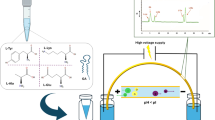Abstract
Nitrosylcobalamin (NO-Cbl), a novel vitamin B12 analog and anti-tumor agent, functions as a biologic ‘Trojan horse’, utilizing the vitamin B12 transcobalamin II transport protein and cell surface receptor to specifically target cancer cells. A stability-indicating HPLC method was developed for the detection of NO-Cbl during forced degradation studies. This method utilized an Ascentis® RP-Amide (150 mm × 4.6 mm, 5 μm) column at 35 °C with a mobile phase (1.0 mL min−1) combining a gradient of methanol and an acetate buffer at pH 6.0. Detection wavelengths of 450 and 254 nm were used to detect corrin and non-corrin-based products, respectively. NO-Cbl, synthesized from hydroxocobalamin and pure nitric oxide gas, was subjected to degradative stress conditions including oxidation, hydrolysis and thermal and radiant energy challenge. The method was validated by assessing linearity, accuracy, precision, detection and quantitation limits and robustness. The method was applied successfully for purity assessment of synthesized NO-Cbl and for the determination of NO-Cbl during kinetic studies in aqueous solution and in solid-state degradation assessments. This HPLC method is suitable for the separation of cobalamins in aqueous and methanolic solutions, for routine detection of NO-Cbl and for purity assessment of synthesized NO-Cbl. Additionally, this method has potential application in identification and monitoring of diseases involving altered nitric oxide homeostasis where vitamin B12 therapy is utilized to scavenge excess nitric oxide, subsequently resulting in the in vivo production of NO-Cbl.



Similar content being viewed by others
References
Rickes EL, Brink NG, Koniuszy FR, Wood TR, Folkers K (1948) Science 107:396–397
Seetharam B, Bose S, Li N (1999) J Nutr 129(10):1761–1764
Expert Group on Vitamins and Minerals Secretariat (2000) Covering note for EVM/00/20/P – review of vitamin B12, pp 1–58
Randaccio L, Geremia S, Demitri N, Wuerges J (2010) Molecules 15(5):3228–3259
van der Kuy PH, Merkus FW, Lohman JJ, ter Berg JW, Hooymans PM (2002) Cephalalgia 22(7):513–519
Gerth K, Ehring T, Braendle M, Schelling P (2006) Clin Toxicol 44(Suppl 1):29–36
Hussain SP, He P, Subleski J, Hofseth LJ, Trivers GE, Mechanic L, Hofseth AB, Bernard M, Schwank J, Nguyen G, Mathe E, Djurickovic D, Haines D, Weiss J, Back T, Gruys E, Laubach VE, Wiltrout RH, Harris CC (2008) Cancer Res 68(17):7130–7136
Sanuphan A, Chunhacha P, Pongrakhananon V, Chanvorachote P (2013) Biomed Res Int 2013:186972
Ashutosh K (2000) Curr Opin Pulm Med 6(1):21–25
Chien JW, Lin CY, Yang KD, Lin CH, Kao JK, Tsai YG (2013) Clin Exp Allergy 43(9):1018–1026
Sweeten TL, Posey DJ, Shankar S, McDougle CJ (2004) Biol Psychiat 55(4):434–437
Tostes MH, Teixeira HC, Gattaz WF, Brandao MA, Raposo NR (2012) Pharmacopsychiatry 45(6):241–243
Kaczka EA, Wolf DE, Kuehl FA Jr, Folkers K (1951) Biophys Acta 73:3569–3573
McLean GR, Pathare PM, Wilbur DS, Morgan AC, Woodhouse CS, Schrader JW, Ziltener HJ (1997) Cancer Res 57(18):4015–4022
Gupta Y, Kohli DV, Jain SK (2008) Crit Rev Ther Drug 25(4):347–379
Allis DG, Fairchild TJ, Doyle RP (2010) Mol BioSyst 6(9):1611–1618
Bauer JA (1998) Anticancer Drugs 9(3):239–244
Bauer JA, Morrison BH, Grane RW, Jacobs BS, Dabney S, Gamero AM, Carnevale KA, Smith DJ, Drazba J, Seetharam B, Lindner DJ (2002) J Natl Cancer Inst 94(13):1010–1019
Chawla-Sarkar M, Bauer JA, Lupica JA, Morrison BH, Tang Z, Oates RK, Almasan A, DiDonato JA, Borden EC, Lindner DJ (2003) J Biol Chem 278(41):39461–39469
Bauer JA, Lupica JA, Schmidt H, Morrison BH, Haney RM, Masci RK, Lee RM, Didonato JA, Lindner DJ (2007) PLoS ONE 2(12):e1313
Bauer JA, Frye G, Bahr A, Gieg J, Brofman P (2010) Invest New Drugs 28(5):694–702
Frenkel EP, Kitchens RL, Prough R (1979) J Chromatogr 174(2):393–400
Lee DS, Griffiths BW (1985) Clin Biochem 18(5):261–266
Kelly RJ, Gruner TM, Sykes AR (2005) Biomed Chromatogr 19(4):329–333
Hardlei TF, Nexo E (2009) Clin Chem 55(5):1002–1010
Lebiedzinska A, Marszall ML, Kuta J, Szefer P (2007) J Chromatogr A 1173(1–2):71–80
Schwertner HA, Valtier S, Bebarta VS (2012) J Chromatogr B 905:10–16
Marley EC, Mackay E, Young G (2009) Food Addit Contam A 26(3):282–288
Brasch NE, Finke RG (1999) J Inorg Biochem 73(4):215–219
Blessy M, Patel RD, Prajapati PN, Agrawal YK (2013) J Pharm Anal (in press)
Acknowledgments
This work was funded in part by federal funds from the National Cancer Institute, National Institutes of Health, Department of Health and Human Services, under SBIR contract number HHSN261201000107C to BNOAT Oncology, Inc.
Author information
Authors and Affiliations
Corresponding author
Additional information
M. J. Dunphy and A. M. Sysel contributed equally to this article.
Rights and permissions
About this article
Cite this article
Dunphy, M.J., Sysel, A.M., Lupica, J.A. et al. A Stability-Indicating HPLC Method for the Determination of Nitrosylcobalamin (NO-Cbl), a Novel Vitamin B12 Analog. Chromatographia 77, 581–589 (2014). https://doi.org/10.1007/s10337-014-2645-5
Received:
Revised:
Accepted:
Published:
Issue Date:
DOI: https://doi.org/10.1007/s10337-014-2645-5




